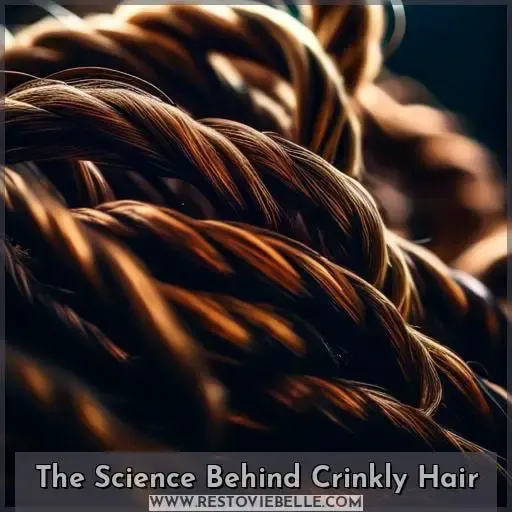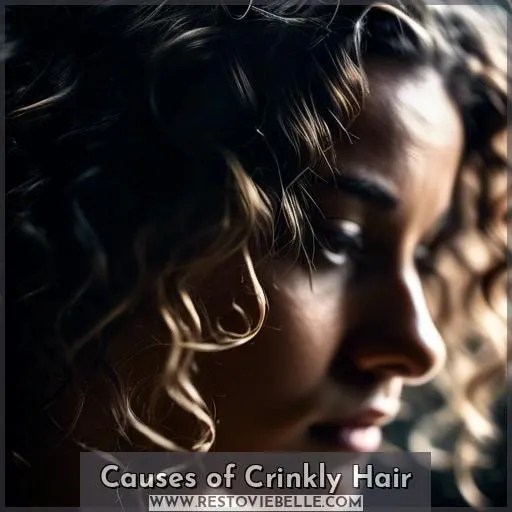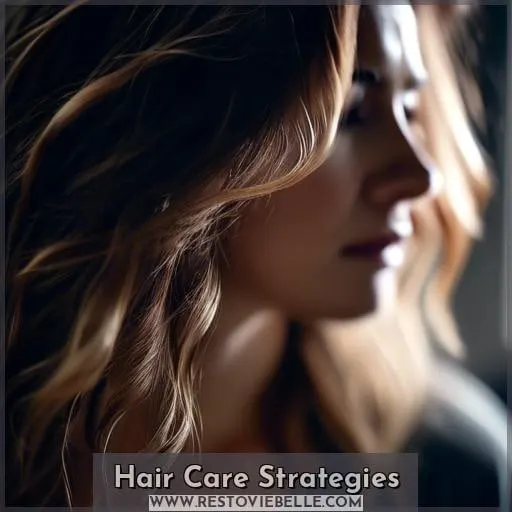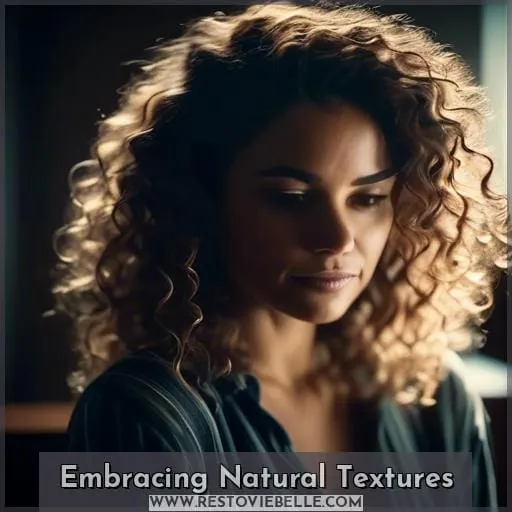This site is supported by our readers. We may earn a commission, at no cost to you, if you purchase through links.
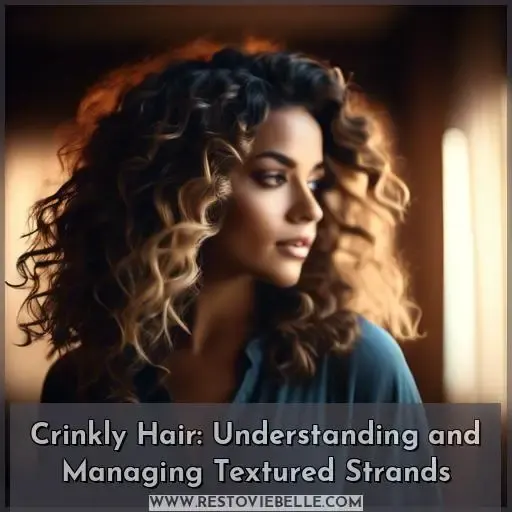 Crinkly hair, with its unique texture and structure, often leaves you wondering about its origins and how best to care for it.
Crinkly hair, with its unique texture and structure, often leaves you wondering about its origins and how best to care for it.
Delving into the science behind crinkly hair reveals a fascinating interplay of genetics, hair structure, and environmental factors. Your hair’s texture, whether crinkly, curly, or straight, is largely determined by the shape of your hair follicles and the distribution of keratin within each strand.
Environmental elements like humidity can further influence your hair’s appearance, making it more prone to frizz and altering its texture.
Damage from chemical treatments, heat styling, and mechanical stress can exacerbate hair’s crinkliness, affecting its health and manageability. Understanding these factors is crucial for adopting effective hair care strategies that emphasize moisture, protection, and gentle handling to maintain the health and beauty of your crinkly strands.
Embracing your hair’s natural texture, with its unique challenges and beauty, fosters a sense of belonging and self-acceptance, guiding you towards a holistic approach to hair care that celebrates and nurtures your individuality.
Table Of Contents
- Key Takeaways
- The Science Behind Crinkly Hair
- Genetic Factors: Influence of Genetics on Hair Texture and Structure
- Hair Structure: Role of the Medulla, Cortex, and Cuticle in Determining Hair Texture
- Environmental Impact: How Humidity and Other Environmental Factors Affect Hair
- Hair Damage: Effects of Chemical Treatments, Heat, and Friction on Hair Health
- Causes of Crinkly Hair
- Hair Care Strategies
- Embracing Natural Textures
- Professional Insights and Solutions
- Consulting Experts: When to Seek Advice From Hairstylists or Dermatologists
- Treatment Options: Overview of Professional Treatments for Damaged Hair
- Product Selection: Guidance on Choosing Products Tailored to Specific Hair Needs
- Home Remedies: Effective DIY Solutions for Improving Hair Texture and Health
- Frequently Asked Questions (FAQs)
- How does hair texture change with age, and can this lead to crinkly strands?
- Can dietary deficiencies contribute to the development of crinkly hair strands?
- How do hormonal changes, such as those during pregnancy or menopause, affect hair texture and crinkliness?
- Are there any specific vitamins or supplements known to improve the health of crinkly hair strands?
- Can wearing hats or head coverings regularly influence the texture of hair and cause crinkliness?
- Conclusion
Key Takeaways
- Hair texture and the appearance of crinkliness can be influenced by the shape of hair follicles, the distribution of keratin, and the angle at which hair grows.
- Environmental factors such as humidity, wind, pollution, and sun exposure can lead to frizz, damage, and changes in hair texture, making hair more prone to crinkliness.
- Hair damage, which can manifest as crinkliness, may result from chemical treatments, heat styling, mechanical stress from hairstyles and handling, and the inability of high porosity hair to retain moisture.
- To care for crinkly hair, it is important to maintain moisture levels, protect hair from environmental stressors, and handle hair gently to preserve its natural texture and prevent further damage.
The Science Behind Crinkly Hair
Understanding the intricacies of crinkly hair requires a deep dive into the biological and environmental factors that shape our hair’s texture and health.
Your hair’s unique characteristics, from its curliness to its susceptibility to damage, are largely determined by the interplay of genetics and the structure of the hair itself, including the medulla, cortex, and cuticle.
Environmental factors such as humidity can further influence your hair’s appearance and condition.
Recognizing the impact of these elements is essential for managing and embracing your hair’s natural texture, while also navigating the challenges posed by damage from chemical treatments, heat, and friction.
Genetic Factors: Influence of Genetics on Hair Texture and Structure
Your crinkly hair strands, which feel rough and bumpy and may disrupt your curl pattern, could be a sign of damage, potentially caused by friction or other factors. It’s not uncommon to have multiple hair textures on one head, and these crinkles might be a natural texture or a result of shrinkage.
Unfortunately, they can’t be completely eliminated, but embracing your hair’s natural texture is a positive approach.
Porosity refers to your hair’s ability to absorb and retain moisture. If your hair is highly porous, it can absorb and lose moisture quickly, which might contribute to the crinkly texture. You can test your hair’s porosity with a strand test or a water float test. Porosity is influenced by chemical treatments, heat, and environmental factors, but there are porosity control products that can help manage it.
The crinkles could be caused by damage from chemical treatments, heat damage, friction, split ends, or porosity issues. To address this, you could cut off the affected strands, use protein treatments to fill in gaps, apply henna to repair damage, use porosity control products, or simply embrace the natural texture of your hair.
Considering your background, the change in environment from southern California to London could have affected your hair due to differences in water, climate, and humidity. The isolated patch of frizzy, tangled hair near your temple, which remains unaffected by various hair products, suggests that the issue might be localized and could be due to a combination of factors, including the angle of hair growth, dryness, or damage.
To prevent further crinkliness, you should condition regularly, limit heat exposure, use hair products suited to your hair type, and trim regularly to remove crinkly ends. If the problem persists, you might want to consult a hairstylist or dermatologist for professional advice and treatment options.
Additionally, incorporating a hair growth routine with products formulated to nourish hair strands could improve the appearance and health of your hair.
Hair Structure: Role of the Medulla, Cortex, and Cuticle in Determining Hair Texture
Dive into the heart of your hair’s unique landscape, where the medulla, cortex, and cuticle play pivotal roles in crafting your hair’s texture.
- Growth Angle: Shapes your hair’s journey, influencing its final appearance.
- Hair Porosity: Determines how well your locks soak up and retain moisture.
- Cortex Damage: Alters strength and elasticity, leading to texture changes.
- Cuticle Damage: Affects smoothness and shine, making strands feel like a bumpy ride.
Environmental Impact: How Humidity and Other Environmental Factors Affect Hair
Humidity’s like that one guest at your hair’s party who just doesn’t know when to leave. When the air’s chock-full of moisture, your hair strands throw their hands up in the air—quite literally—and frizz takes the stage.
It’s all about those hydrogen bonds; they’re the social butterflies of the hair world, mingling with water molecules and throwing your hair’s style out of whack.
If your hair’s got a high porosity, it’s like a sponge, soaking up that moisture and puffing up like a soufflé. On the flip side, if your locks are on the drier side, they’ll guzzle up humidity like it’s happy hour, leading to a frizz fest.
So, when the weather’s serving up a steamy dish of high humidity, it’s prime time to double down on hydration and keep your hair’s thirst quenched to fend off the frizz fiesta.
Hair Damage: Effects of Chemical Treatments, Heat, and Friction on Hair Health
Your hair’s health is like a delicate fabric – treat it harshly, and it’ll show wear and tear. Chemical treatments, heat styling, and even the friction from your pillowcase can fray your hair’s edges, leading to damage that manifests as those pesky crinkles.
It’s a battle of the strands, and your hair is the battlefield where split ends and breakage lay siege.
- Chemical treatments are like double agents, promising sleek styles but secretly sabotaging your hair’s integrity.
- Heat damage turns your hair’s moisture into a distant mirage, leaving it parched and brittle.
- Friction effects from everyday activities can rough up your hair’s cuticle, leading to a texture that’s more tangled than a mystery novel.
- Hair damage doesn’t just affect your look; it’s a blow to your hair’s morale, leaving it less resilient and more prone to breakage.
Causes of Crinkly Hair
When you notice your hair developing a crinkly texture, it’s essential to consider the potential causes.
Chemical treatments such as dyes and relaxers can alter your hair’s natural texture, leading to damage and a rougher feel.
Excessive use of heat styling tools can also contribute to this issue, causing your strands to become brittle and more prone to breakage.
Additionally, mechanical stress from certain hairstyles and handling can impact your hair structure, while high porosity may make your hair more susceptible to crinkliness due to its increased difficulty in retaining moisture.
Chemical Treatments: Impact of Dyes and Relaxers on Hair Texture
After diving into the science of crinkly hair, let’s tackle the beast of chemical treatments. Dyes and relaxers can be like double-edged swords, offering style but risking strife. They can lead to chemical damage, cuticle peeling, and even hair breakage. It’s a tricky balance, like walking a tightrope between fabulous color and the frizz frenzy.
| Treatment | Risk | Symptom |
|---|---|---|
| Hair Dye | Protein Loss | Color Fading |
| Hair Bleach | Cuticle Peeling | Hair Breakage |
| Hair Relaxer | Chemical Damage | Frizz, Dryness |
| Styling Tools | Heat Damage | Split Ends |
| Rough Handling | Mechanical Stress | Tangles, Frizz |
Heat Damage: Consequences of Excessive Use of Styling Tools
Given the context of the user’s experience with their hair after moving from southern California to London, it seems that the small patch of extremely frizzy, tangled, and bent hair near the temple could be a result of environmental changes, particularly the difference in humidity and possibly water quality between the two locations.
The fact that the hair problem began a few days after arriving in London and is isolated to a small patch suggests that it may not be due to styling habits, as the user doesn’t usually blow dry their hair and the problem persists regardless of blow drying.
The crinkly strands near the temple could be a result of the hair’s reaction to the new environment, which may have a higher humidity level than southern California, leading to frizz and changes in hair texture.
Additionally, the water in London may have different mineral content, which could affect hair condition. The user’s long, straight, and slightly wavy hair with no history of frizz suggests that the hair’s natural texture isn’t the cause of the problem.
The user has tried various hair products without success, indicating that the bent hair strands may be resistant to these treatments. This could be due to damage from the environmental change or a need for more specialized products to address the specific issue.
The user’s related experience with a similar hair problem in Nevada, another location with a different climate than southern California, further supports the idea that environmental factors are playing a significant role in the hair condition.
In summary, the crinkly strands near the temple are likely due to the change in environment after moving from southern California to London, with humidity and water quality being potential contributing factors.
The user’s usual hair care practices don’t seem to be the cause, and the ineffectiveness of various hair products suggests that a more targeted approach may be necessary to address the issue.
Mechanical Stress: Effects of Hairstyles and Handling on Hair Structure
Continuing from the woes of heat damage, let’s not overlook the sneaky culprit of crinkly hair: mechanical stress. Your hairstyle choices and brushing habits might be staging a silent protest on your scalp.
- Scalp Tension: That sleek ponytail may look chic, but it’s secretly pulling a fast one on your hair roots.
- Ponytail Damage: Ever heard of ‘ponytail headache’? It’s not just in your head; it’s your hair crying out for a break.
- Brushing Habits: Brushing like you’re taming a wild beast? Your hair’s not wild; it’s just misunderstood.
- Friction Reduction: Silk pillowcases aren’t just luxury; they’re your hair’s night armor against the friction fiend.
Porosity Issues: How High Porosity Contributes to Hair Crinkliness
After wrestling with the tangles of mechanical stress, let’s dive into the deep end of porosity issues.
High porosity, akin to a sponge that’s seen better days, leads to hygral fatigue from constant hygral expansion and contraction. This rollercoaster ride leaves your hair texture waving the white flag, transforming sleek strands into the rebellious crinkly hair we’re all too familiar with.
Hair Care Strategies
To manage crinkly hair effectively, it’s essential to integrate a moisturizing routine that includes regular conditioning and deep hydration treatments.
Protecting your hair from heat damage is also crucial, so always apply a heat protectant before using styling tools.
Additionally, gentle handling of your hair can reduce mechanical stress, and regular trims are vital for keeping crinkly ends in check and maintaining the overall health of your hair.
Moisturizing Routines: Importance of Regular Conditioning and Deep Hydration
Continuing from the woes of chemical treatments and heat styling, let’s dive into the oasis of moisturizing routines. Your hair’s thirst for deep hydration is real, and regular conditioning is just the first sip.
Imagine your hair as a sponge in the desert, parched for moisture; a leave-in conditioner is like a sudden drizzle, offering a quick quench. But for a downpour that truly soaks to the core, hair masks are your monsoon season.
They’re the secret to moisture retention, turning brittle strands into a lush, flowing mane.
Now, don’t just slap on that deep conditioner and hope for the best. Think of it as a spa day for your scalp and strands. Give it time to penetrate the depths of your hair’s cortex, much like a patient gardener nurturing the roots for a bountiful harvest.
And for those with kinky hair, this isn’t just advice; it’s a hair care commandment. Embrace these hair care tips and tricks, and you’ll transform that frizzy patch into a silken tapestry. Remember, your hair care blog wouldn’t steer you wrong; this is the hair care advice that could elevate your routine from routine to royal.
Heat Protection: Guidelines for Minimizing Heat Damage
To shield your locks from the ravages of heat, it’s essential to arm yourself with the right tools and techniques.
- Always prep with a heat protectant: Before you even plug in your styling tools, spritz on a barrier of protection. Think of it as sunscreen for your strands.
- Choose the right temperature: Cranking up the heat isn’t always better. Match the heat setting to your hair type—fine hair needs less, while thicker locks can handle more.
- Keep it moving: Don’t let heat linger. Use swift, smooth motions with your hair dryer or iron to avoid scorching any one spot.
- Invest in quality tools: A good hair brush or comb can make all the difference. Look for ones that help distribute heat evenly and gently detangle.
- Regular trims are your friend: Snipping off those crinkly ends can prevent further damage and keep your hair looking healthy.
Gentle Handling: Recommendations for Reducing Mechanical Stress on Hair
To keep your crinkly strands happy and healthy, it’s all about gentle handling to minimize mechanical stress.
| Do’s | Don’ts | Why |
|---|---|---|
| Use a wide-tooth comb | Brush wet hair | Prevents breakage |
| Detangle from ends to roots | Rip through knots | Reduces hair stress |
| Opt for silk pillowcases | Use rough fabrics | Less friction at night |
Trimming: Role of Regular Trims in Managing Crinkly Ends
Continuing from the importance of gentle handling, let’s talk trims. You know, those regular snips that keep your hair from going rogue.
-
Trim Frequency: Regular trims prevent split ends from traveling up the hair shaft, which can cause more damage. Aim for every 6-8 weeks to keep your hair in check.
-
Split End Reduction: Snipping off those frazzled ends not only keeps your hair looking neat, but also helps with moisture retention, making your mane easier to manage.
-
Damage Prevention: Regular trims are like a tune-up for your hair, helping to prevent breakage and maintain hair growth. It’s like saying goodbye to the old to welcome the healthy new.
Embracing Natural Textures
Embracing your natural hair texture, especially when it comes to crinkly strands, is a journey of self-acceptance and understanding the unique beauty of your hair.
Recognizing that your head may host a variety of textures is the first step towards embracing and styling your hair in a way that prevents damage while enhancing its natural form.
By adopting a holistic approach to hair care, you can learn to love and care for your crinkly strands, seeing them not as a challenge but as a distinctive part of your identity.
Understanding Natural Variability: Recognizing the Diversity of Hair Textures on a Single Head
As you’ve been nurturing your locks with tender care, remember that your head is a tapestry of diverse strands, each with its own whimsical dance.
You might find a cluster of crinkly strands that seem to march to the beat of their own drum, disrupting the smooth waves you’re used to. But here’s the twist: that’s the beauty of hair diversity. Embracing individuality isn’t just about loving the hair that falls in line; it’s about celebrating the rebels that add character to your mane.
So, while you might be tempted to wage war on those crinkles, consider this: they’re a part of your unique story, a testament to the rich tapestry of textures that make you, well, you.
After all, loving uniqueness is about more than just acceptance; it’s about reveling in the quirks that set you apart. Celebrate those differences with pride, and watch as your hair tells its own vibrant tale.
Self-Acceptance: Encouraging the Embrace of One’s Natural Hair Texture
Embrace uniqueness, celebrate diversity, and cherish your natural beauty. Your hair is a tapestry of individual style, a crown of hair appreciation that doesn’t need to conform to a single standard.
- Celebrate Your Hair’s Story: Every strand holds a chapter of your life. Whether it’s the waves from your beach days or the curls from your heritage, each kink and coil is a character in your story.
- Discover Hair Care Secrets: Dive into the world of hair care articles and uncover the rituals that resonate with your hair’s needs. Your mane is unique; treat it to a tailored routine.
- Embrace Hair Care Hacks: Sometimes, the simplest tweaks make the biggest difference. Find those hair care hacks that turn your hair care routine into a joy rather than a chore.
Your hair’s quirks aren’t flaws; they’re signatures of your essence. So, laugh in the face of bad hair days and remember, the journey to self-acceptance is as winding as your wildest curl.
Styling Tips: Suggestions for Styling Mixed-texture Hair Without Causing Damage
When it comes to styling mixed-texture hair without causing damage, the key is to embrace and protect your unique curls.
Dive into the world of protective styling, which includes buns, braids, cornrows, and twists. These styles not only save time but also shield your hair from daily wear and tear.
Opt for products rich in natural ingredients like shea butter, coconut oil, and argan oil, which provide intense moisture and help define those beautiful curls.
For defining curls and preventing frizz, consider finger coiling or using curl-defining creams to enhance your natural curl pattern while keeping your hair hydrated and happy.
Embracing your hair’s natural texture and employing the right care and styling techniques can lead to healthier, more beautiful hair.
Professional Insights and Solutions
When dealing with crinkly hair, it’s essential to seek professional insights and solutions tailored to your specific needs. Hairstylists and dermatologists can offer valuable advice on treatment options for damaged hair, guiding you towards products that match your hair’s unique characteristics.
Embracing effective DIY solutions, alongside professional treatments, can significantly improve your hair’s texture and health, ensuring you maintain its natural beauty and resilience.
Consulting Experts: When to Seek Advice From Hairstylists or Dermatologists
When your mane starts acting like a rebellious teenager, it’s time to call in the pros. If your locks have more twists and turns than a mystery novel, and you’ve tried every potion and incantation from the hair care website archives, it might be time for some professional advice.
A trip to a hairstylist or a medical consultation with a dermatologist can unravel the tangled web of hair care myths and facts.
Your stylist can offer expert recommendations on products and styling techniques that won’t add to the drama. Meanwhile, a dermatologist can provide specialist insights into any underlying scalp or hair health issues.
They’re like the Sherlock Holmes of hair, using their diagnostic skills to get to the root of the problem. And if you’re feeling lost in the sea of hair care tutorials and videos, these experts can be your lighthouse, guiding you back to the shores of good hair days.
So, if your tresses are throwing a tantrum, don’t just stand there like you’ve been struck by a smooth criminal. Seek out dermatologist guidance or a stylist’s touch. They’ll help you embrace your natural texture, turning your hair woes into hair wows.
Treatment Options: Overview of Professional Treatments for Damaged Hair
After consulting with experts, you’re ready to dive into the world of professional treatments for those pesky crinkles.
Keratin treatments are like a knight in shining armor for your hair, smoothing out the rough edges and adding a glossy sheen.
Think of Olaplex treatments as the secret agents, rebuilding your hair’s bonds from the inside out.
Protein treatments are the muscle, reinforcing your strands to stand up to daily battles with brushes and blow dryers.
And let’s not forget deep conditioning – it’s like a spa day for your hair, infusing moisture and peace into every strand.
When you step into a hair salon, your stylist, armed with the latest hair care research, can tailor these treatments to your hair’s unique needs.
It’s like finding the perfect dance partner for your hair’s rhythm, ensuring every step is smooth and every twirl is tight.
So, don’t let those crinkles get you down; with the right professional touch, your hair can be the life of the party.
Product Selection: Guidance on Choosing Products Tailored to Specific Hair Needs
After diving into the world of professional treatments for those pesky crinkles, let’s talk shop about product selection. You’re not just picking any old bottle off the shelf; you’re on a quest for the holy grail of hair care that caters to your unique tresses.
Think of it as matchmaking for your mane—finding that perfect partner in the form of a shampoo or serum that just gets your hair’s needs.
When you’re on the hunt, keep your eyes peeled for product ingredients that’ll treat your hair like royalty. Shea butter and argan oil? They’re the knights in shining armor for dry, thirsty strands. Glycerin’s your go-to for that just-right moisture balance, while steering clear of the no-goodniks like sulfates and parabens is a must for keeping your hair in the clear.
Custom routines are your secret weapon. They’re like a bespoke suit for your hair—tailored to perfection. And don’t even get me started on brand recommendations. It’s like finding a trusted confidant in the crowded hair care market.
They know the ins and outs of hair care innovation and will keep you in the loop with the latest hair care news and events.
Hair typing isn’t just a fad; it’s the roadmap to understanding your locks. And moisture levels? They’re the barometer of your hair’s health. So, whether you’re a curly Sue or a straight-laced Jane, remember: your hair’s as unique as you are, and finding the right products is key to letting those strands live their best life.
Home Remedies: Effective DIY Solutions for Improving Hair Texture and Health
To whip your crinkly strands into shape, consider some DIY solutions that harness the power of natural ingredients.
Homemade masks can be a godsend for your scalp health and overall hair health. For instance, a simple concoction of egg, olive oil, and avocado can work as a protein-packed punch to strengthen those frizzy fighters near your temple.
Or perhaps a yogurt and honey mask to moisturize and reduce breakage, ensuring your hair doesn’t wave the white flag too soon.
Frequently Asked Questions (FAQs)
How does hair texture change with age, and can this lead to crinkly strands?
As you age, your hair may play a game of switcheroo, becoming thinner, less elastic, and sometimes a bit rebellious with crinkly strands.
It’s like your locks are throwing a mid-life party without asking!
Can dietary deficiencies contribute to the development of crinkly hair strands?
Yes, dietary deficiencies can indeed be the root of your crinkly hair woes, acting like a garden without water—starved of the nutrients needed to flourish.
Ensuring a balanced diet rich in vitamins and minerals is key to nurturing healthier strands.
How do hormonal changes, such as those during pregnancy or menopause, affect hair texture and crinkliness?
Hormonal changes during pregnancy and menopause can make your mane a wild ride.
Estrogen’s dip often leads to drier, more brittle locks and sometimes a frizz fest.
Are there any specific vitamins or supplements known to improve the health of crinkly hair strands?
Vitamins like biotin and zinc are your hair’s best friends, acting like a spa day for your crinkly strands.
Imagine biotin as the smoothie that feeds your hair from within, while zinc acts like the bouncer, keeping out the bad guys that cause damage.
Together, they’re a dynamic duo, turning frizzy, tangled messes into sleek, healthy locks.
So, before you throw in the towel, give these supplements a shot; your hair might just thank you with a bounce and shine that turns heads.
Can wearing hats or head coverings regularly influence the texture of hair and cause crinkliness?
Yes, wearing hats or head coverings regularly can influence the texture of your hair, potentially leading to crinkliness. Tight hats may cause traction alopecia, a form of hair loss due to pulling on the hair, and dirty or sweaty headgear can affect scalp health, leading to issues like itchiness or lifeless hair.
However, hats themselves don’t directly cause hair loss. It’s more about how and how often they’re worn. To keep your locks luscious under your lid, opt for loose-fitting, breathable materials and keep your headgear clean.
Conclusion
Your crinkly hair is a tapestry, each strand weaving the story of your unique identity. It’s essential to nurture this natural masterpiece with tailored care, embracing its texture and responding to its needs.

